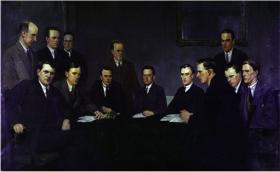Leo Whelan’s IRA GHQ staff, 1921
Published in 20th-century / Contemporary History, Features, Issue 1 (Jan/Feb 2009), Revolutionary Period 1912-23, Volume 17
Michael Collins (intelligence), Richard Mulcahy (chief-of-staff), Gearóid O’Sullivan (adjutant-general), Eamon Price (organisation), Rory O’Connor (engineering & OC Britain), Eóin O’Duffy (assistant chief-of-staff), Seán Russell (munitions), and Seán McMahon (quartermaster-general). Standing: J. J. O’Connell (training), Emmet Dalton (operational training), Seán Donovan (chemicals), Liam Mellowes (purchases), and Piaras Beaslai (publicity).
On the Saturday following the truce of 11 July 1921, my father, Richard Mulcahy, IRA chief-of-staff, went with my mother Min to the Gresham Hotel in O’Connell Street for afternoon tea. It was his first public appearance, having been on the run for the previous eighteen months. The well-known painter Leo Whelan was sitting close by with a priest friend and a conversation ensued. My mother suggested to Whelan that, now that a truce had been arranged, it might be a good opportunity to paint the members of the IRA’s general headquarters (GHQ) staff, who were now free to appear in public. Whelan was enthusiastic about the idea.
There were thirteen members on the staff during the last six months of the War of Independence. Whelan arranged separate sittings for each over the following months—a challenge during a very hectic period, particularly for Collins and the more active leaders. Having completed each portrait, Whelan painted a composite picture of the thirteen men in late 1922/early 1923.
Nothing was heard of the composite painting until 1945. It was left on the top landing of Whelan’s residence in Eccles Street but, following a roof leak, was transferred to his studio. There it came to the attention of an Irish Independent correspondent, who, in a front-page article on 10 November 1945, described it as ‘a striking picture by this great painter, which is at once a work of exceptional artistic merit and a document of rare historic value’. It was exhibited at the Royal Hibernian Academy (RHA) the following year and was offered to the Fianna Fáil government, but turned down. It was turned down again by the first inter-party government in 1948. (Whelan’s asking price was £1,500.)
While going through some of my father’s papers in 1962 I came across a brief newspaper reference to the 1946 RHA exhibition. It was clear that this uniquely historical picture had again been forgotten. We decided to discover its whereabouts and, if possible, purchase the painting. Within two days my father and mother were having afternoon tea with the two surviving Whelan sisters in Eccles Street. A few days later I paid a more business-like call and found the painting in ghostly and dusty isolation straddling the upper landing of the old and decaying Georgian building. After much beating around the bush, a price of £1,300 was agreed and the canvas was transferred to the Hugh Lane Gallery, Parnell Square, where it was cleaned, re-framed, hung and cared for by the curator, James White. It went with White when he was appointed to the National Gallery, and eventually it returned to my own house in Leeson Park.
In 1987 the picture was transferred to McKee Barracks on long-term loan, but because of its historical significance it deserved a wider public. I therefore offered it to Taoiseach Charles Haughey in 1991, but because we couldn’t agree on where it should hang it wasn’t until 1994, when Albert Reynolds was taoiseach, that my renewed offer was accepted. The picture now hangs permanently over the staircase of the west wing of the National Museum, Collins Barracks, on the way into the permanent exhibition Soldiers and Chiefs: the Irish at war. HI
Risteárd Mulcahy is a retired cardiologist.


















